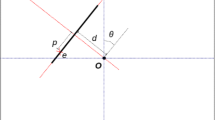Abstract
We introduce Erosion Band Signatures (EBS), which are a codification of the spatial coherence of features extracted from a region. This coherence is often lost in traditional global and local feature extraction methods, thereby diminishing a feature’s discriminative strength. The erosion band signature is generated through iterative erosions of the region of interest, forming what we call erosion bands. Features are then extracted from each band and accumulated in a specific order to form the EB signature, which preserves spatial information of the features. To demonstrate the versatility of EBS, we have implemented the method in two very different applications: polyp detection and region-based head tracking. In polyp detection, EBS provides an effective way to characterize spatial differences between the perimeter and core of a polyp candidate, and improves a state-of-the-art computer-aided detection method with an improved 27.6% reduction of false positives. We also apply EBS analysis to region-based tracking yielding a very clear improvement in both robustness and accuracy.
Similar content being viewed by others
References
Mikolajczyk K., Schmid C.: A performance evaluation of local descriptors. IEEE Trans. Pattern Anal. Mach. Intell. 27(10), 1615–1630 (2005)
Slabaugh G., Yang X., Ye X., Boyes R., Beddoe G.: A robust and fast system for ctc computer-aided detection of colorectal lesions. Algorithms 3(1), 21–43 (2010)
Nappi J., Yoshida H.: Feature-guided analysis for reduction of false positives in CAD of polyps for computed tomographic colonography. Med. Phys. 30(7), 1592–1601 (2003)
Wang Z., Liang Z., Li L., Li X., Li B., Anderson J., Harrington D.: Reduction of false positives by internal features for polyp detection in CT-based virtual colonoscopy. Med. Phys. 32(12), 3602–3616 (2005)
Birchfield, S.: Elliptical head tracking using intensity gradients and color histograms, pp. 232–237. IEEE Computer Society Conference on Computer Vision and Pattern Recognition (CVPR’98) (1998)
Birchfield, S.T., Rangarajan, S.: Spatiograms versus histograms for region-based tracking, vol. 2, pp. 1158–1163. IEEE Computer Society Conference on Computer Vision and Pattern Recognition (CVPRć605) (2005)
Yoshida H., Nappi J.: Three-dimensional computer-aided diagnosis scheme for detection of colonic polyps. IEEE Trans. Med. Imaging 20(12), 1261–1274 (2002)
Lefere P., Gryspeerdt S., Marrannes J., Baekelandt M., Van Holsbeeck B.: CT colonography after fecal tagging with a reduced cathartic cleansing and a reduced volume of barium. Am. J. Roentgenol. 184(6), 1836–1842 (2005)
Lawrence E.M., Pickhardt P.J., Kim D.H., Robbins J.B.: Colorectal polyps: stand-alone performance of computer-aided detection in a large asymptomatic screening population. Radiology 256(3), 791–798 (2010)
Zhu H., Liang Z., Pickhardt P.J., Barish M.A., You J., Fan Y., Lu H., Posniak E.J., Richards R.J., Cohen H.L.: Increasing computer-aided detection specificity by projection features for CT colonography. Med. Phys. 37(4), 1468–1480 (2010)
Pickhardt P.J.: Translucency rendering in 3D endoluminal CT colonography: a useful tool for increasing polyp specificity and decreasing interpretation time. Am. J. Roentgenol. 183(2), 429–436 (2004)
Levoy, M.: Rendering of Surfaces from Volumetric Data. Technical Report 87-016, Computer Science Department, University of North Carolina (1987)
Shahbazi, M., Sattari, M., Ghazic, M.: Automatic polyp detection from CT colonography using mathematical morphology, pp. 823–828. In: Proceedings of the 21st ISPRS Congress (2008)
Wang, Z., Li, L., Anderson, J., Harrington, D., Liang, Z.: Colonic polyp characterization and detection based on both morphological and texture features, pp. 23–26. In: Proceedings of the 18th International Congress and Exhibition on Computer Assisted Radiology and Surgery (2004)
Sarkar A., Singh V., Ghosh P., Manjunath B.S., Singh A.: Efficient and robust detection of duplicate videos in a large database. IEEE Trans. Circuits Syst. Video Technol. 20(6), 870–885 (2010)
Lucas, B., Kanade, T.: An iterative image registration technique with an application to stereo vision, pp. 674–679. In: Proceedings of the International Joint Conference on Artificial Intelligence (1981)
Matthews L., Ishikawa T., Baker S.: The template update problem. IEEE Trans. Pattern Anal. Mach. Intell. 26(6), 810–815 (2004)
Elgammal, A., Duraiswami, R., Davis, L.S.: Probabilistic tracking in joint feature-spatial spaces, vol. 1, pp. 773–781. In: IEEE Computer Society Conference on Proceedings of the Computer Vision and Pattern Recognition (2003)
Hong W., Qiu F., Kaufman A.: A pipeline for computer aided polyp detection. IEEE Trans. Vis. Comput. Graphics 12(5), 861–868 (2006)
Dalal, N., Triggs, B.: Histograms of oriented gradients for human detection, vol. 1, pp. 886–893. In: IEEE Computer Society Conference on Proceedings of CVPR05 (2005)
Bowman A.W., Azzalini A.: Applied Smoothing Techniques for Data Analysis: The Kernel Approach with S-plus Illustrations. Oxford University Press, USA (1997)
Sheather S.J.: Density estimation. Stat. Sci. 19(4), 588–597 (2004)
Botev Z.I., Grotowski J.F., Kroese D.P.: Kernel density estimation via diffusion. Ann. Stat. 38(5), 2916–2957 (2010)
De Silva V., Tenenbaum J.B.: Global versus local methods in nonlinear dimensionality reduction. Proc. NIPS 1256, 721–728 (2003)
Tenenbaum J.B., Silva V., Langford J.C.: A global geometric framework for nonlinear dimensionality reduction. Science 290(5500), 2319–2323 (2000)
Belkin M., Niyogi P.: Laplacian eigenmaps for dimensionality reduction and data representation. Neural Comput. 15(6), 1373–1396 (2003)
Yang L.: Distance Metric Learning: A Comprehensive Survey. Technical report. Michigan State University, East Lansing (2006)
Sangwine S.J., Horne R.E.N.: The Colour Image Processing Handbook. CRC Press, Boca Raton (1998)
Conaire, C.O., O’Connor, N.E., Smeaton, A.F.: An improved spatiogram similarity measure for robust object localisation, pp. 1069–1072. IEEE International Conference on Acoustics, Speech and Signal Processing (ICASSP 2007) (1998)
Jain A.K., Duin R.P.W., Mao J.: Statistical pattern recognition: a review. IEEE Trans. Pattern Anal. Mach. Intell. 22(1), 4–37 (2000)
Fisher R.A.: The use of multiple measurements in taxonomic problems. Ann. Eugen. 7(1), 179–188 (1936)
Cortes C., Vapnik V.: Support-vector networks. Mach. Learn. 20(3), 273–297 (1995)
Author information
Authors and Affiliations
Corresponding author
Rights and permissions
About this article
Cite this article
Vazquez, E., Yang, X. & Slabaugh, G. Erosion band signatures for spatial extraction of features. Machine Vision and Applications 24, 695–705 (2013). https://doi.org/10.1007/s00138-012-0422-8
Received:
Revised:
Accepted:
Published:
Issue Date:
DOI: https://doi.org/10.1007/s00138-012-0422-8




